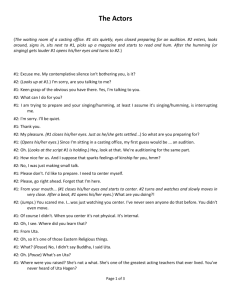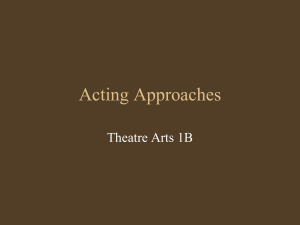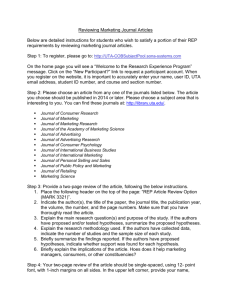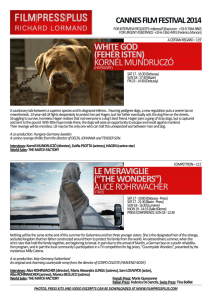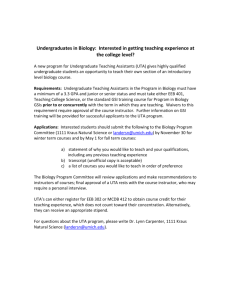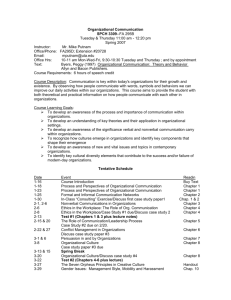Uta Hagen's Object Exercises by Meagan Wright
advertisement
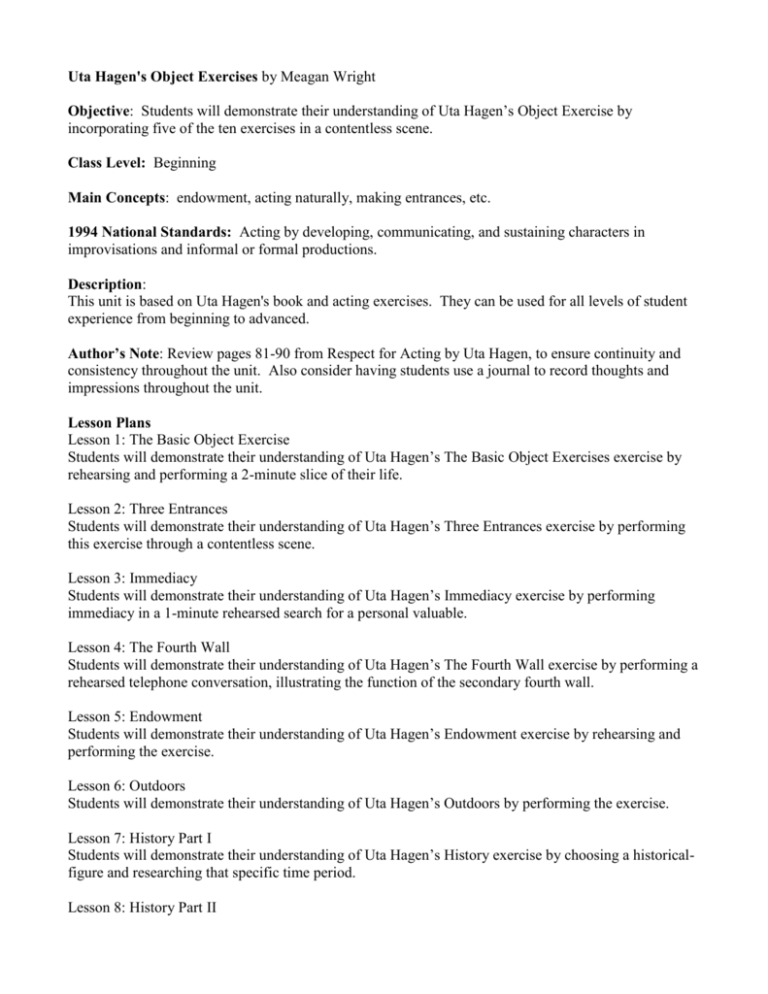
Uta Hagen's Object Exercises by Meagan Wright Objective: Students will demonstrate their understanding of Uta Hagen’s Object Exercise by incorporating five of the ten exercises in a contentless scene. Class Level: Beginning Main Concepts: endowment, acting naturally, making entrances, etc. 1994 National Standards: Acting by developing, communicating, and sustaining characters in improvisations and informal or formal productions. Description: This unit is based on Uta Hagen's book and acting exercises. They can be used for all levels of student experience from beginning to advanced. Author’s Note: Review pages 81-90 from Respect for Acting by Uta Hagen, to ensure continuity and consistency throughout the unit. Also consider having students use a journal to record thoughts and impressions throughout the unit. Lesson Plans Lesson 1: The Basic Object Exercise Students will demonstrate their understanding of Uta Hagen’s The Basic Object Exercises exercise by rehearsing and performing a 2-minute slice of their life. Lesson 2: Three Entrances Students will demonstrate their understanding of Uta Hagen’s Three Entrances exercise by performing this exercise through a contentless scene. Lesson 3: Immediacy Students will demonstrate their understanding of Uta Hagen’s Immediacy exercise by performing immediacy in a 1-minute rehearsed search for a personal valuable. Lesson 4: The Fourth Wall Students will demonstrate their understanding of Uta Hagen’s The Fourth Wall exercise by performing a rehearsed telephone conversation, illustrating the function of the secondary fourth wall. Lesson 5: Endowment Students will demonstrate their understanding of Uta Hagen’s Endowment exercise by rehearsing and performing the exercise. Lesson 6: Outdoors Students will demonstrate their understanding of Uta Hagen’s Outdoors by performing the exercise. Lesson 7: History Part I Students will demonstrate their understanding of Uta Hagen’s History exercise by choosing a historicalfigure and researching that specific time period. Lesson 8: History Part II Students will demonstrate their understanding of Uta Hagen’s History exercise by performing a historically-accurate “simple task”. Lesson 9: Talking to Yourself and Character Action Students will demonstrate their understanding of Uta Hagen’s Talking to Yourself and Character Action exercises by teaching the exercise and facilitating a corresponding activity. Lesson 10: Conditioning Forces Students will demonstrate their understanding of Uta Hagen’s Conditioning Forces exercise by participating in a modified version of the theatre game “Freeze”. Lesson 11: Rehearsal Students will demonstrate their understanding of Uta Hagen’s Object Exercise by incorporating five of the ten exercises in a contentless scene. Lesson 12: Contentless Scene Final Performance Students will demonstrate their understanding of Uta Hagen’s Object Exercise by incorporating five of the ten exercises in a contentless scene. 1. The Basic Object Exercise Objective Students will demonstrate their understanding of Uta Hagen’s The Basic Object Exercises exercise by rehearsing and performing a 2-minute slice of their life. Materials Needed · Respect for Acting by Uta Hagen (preferably one per student) Lesson Directions Anticipatory Set/Hook Conduct a number of physical exercises (i.e. ab exercises, bicep exercises, squat exercises, etc.). Ask students why athletes perform warm-up exercises (possible answers: for training, to warm-up, to improve craft, etc.) Inform them that just as athletes have specific warm-up exercises, Uta Hagen (renowned actor and director) has created exercises for actors. Transition to the first exercise by reading from Uta Hagen’s book, Respect for Acting. (Detailed instructions below) Instruction Step 1: · As a class, read Uta Hagen’s Respect for Acting, pages 81-86. · Throughout the reading, periodically asks students o to summarize what they’ve read o for examples from their individual lives Step 2: · Based on the reading, students must now decide a moment in their daily life when they can apply the principles discussed in the reading · Specifically they need to think of something where they’re able to answer the following questions: 1. Who am I? 2. What time is it? 3. Where am I? 4. What surrounds me? 5. What are the given circumstances? 6. What is my relationship? 7. What do I want? 8. What’s in my way? 9. What do I do to get what I want? (For additional examples or further clarification, read pages 91-94 ) · Once they determine the situation they want to use in their exercise, have students write a detailed description of the occurrence. (They will turn this in after they perform.) Step 3: · Once students have had sufficient time to practice the exercise and scene, have them perform · To performers: emphasize that they are simply trying to “recreate 2 minutes of their life and bring it to presentation as if for the first time” CLOSURE: · Once everyone has performed, discuss their process in doing this exercise (Possible questions: what did this exercise do for you? How did it help you? How do you think it can help the performance overall?, etc.) · Conclude by emphasizing “all technical variations of the ensuing exercises incorporate the elements you have examined in this one. Don’t omit any of them.” (page 94) Assessment Participation: Implementation of Exercise: Write up: Total possible points: 10pts 5pts 5 pt 20 pts Implementation of Exercise POINT VALUE Description of Qualifying Standard Points Barely understands the exercise and its 1 application to improving one’s acting ability Sufficiently understands the exercise and 3 its application to improving one’s acting ability Understands the exercise and successfully 5 applies it to improve one’s acting ability 2. Three Entrances Objective Students will demonstrate their understanding of Uta Hagen’s Three Entrances exercise by performing this exercise through a contentless scene. Materials Needed · Make necessary arrangements for “the errand” · Respect for Acting by Uta Hagen · Contentless scenes · Performance space Lesson Directions Anticipatory Set/Hook Assuming that appropriate arrangements have been made, ask a student (preferably a TA) to “run an errand” for you (e.g. turn in a paper at the front office, drop off supplies to Ms. So-and-so, etc.). While the student is gone, tell your class to observe “how” the student “enters” the classroom when he returns. Advise them to be inconspicuous in their observations as to not make the errand-runner feel awkward. After the student returns, discuss what the class observed. (Focus the discussion to reveal possible answers to “What he just did? What he is doing now? and What is the first thing he wants?) Instruction Step 1: · As a class, read Uta Hagen’s Respect for Acting, pages 95-101. · Throughout the reading, periodically asks students o to summarize what they’ve read o for examples from productions they’ve seen o for personal experiences they’ve had GOAL: Students will have an understanding of 1. how important a purposeful entrance is 2. the exercise Ask yourself: What did you just do? (do this offstage); What are you doing now? (do this while entering stage); What’s the first thing you want to do? (this question enhances entrances with purpose). For example: I just ate a cookie and so now I’m dusting the crumbs off my shirt, and I want a cold glass of milk to wash it down. Step 2: · Have students find a partner; pass out a contentless scene to each partnership · Once students have identified their “entrance”, instruct them to determine 1. What they were doing right before the scene started 2. What they are doing as the scene starts 3. What their first object is once the scene starts · As soon as the students determine this, have them act out these choices before moving into their contentless scene. · Have them rehearse for 10-15 minutes their entrance exercise as they transition into their contentless scene Step 3: · Once students have had sufficient time to practice the exercise and scene, begin performing. · To performers: emphasize focus on the entrance exercise · To viewers: based on the entrances, try to answer the three questions posed in the reading (what just happened? what’s happening now? what do they want?) GOAL: Students will 1. improve their entrances by adding detail and purpose 2. observe enhanced entrances through the addition of detail and purpose CLOSURE: · After each performance, discuss possible occurrences that might have happened before the contentless scene started, based on the entrance · Once everyone has performed, discuss their process in doing this exercise (Possible questions: what did this exercise do for you? How did it help you? How do you think it can help the performance overall?, etc.) Conclude by rereading the final paragraph from this chapter on page 101. Assessment Participation: Implementation of Exercise: Total possible points: 10pts 5pts 15pts Implementation of Exercise POINT VALUE Description of Qualifying Standard Points Barely understands the exercise and its 1 application to improving one’s acting ability Sufficiently understands the exercise and 3 its application to improving one’s acting ability Understands the exercise and successfully 5 applies it to improve one’s acting ability 3. Immediacy Objective Students will demonstrate their understanding of Uta Hagen’s Immediacy exercise by performing immediacy in a 1-minute rehearsed search for a personal valuable. Materials Needed · Candy bar · Respect for Acting by Uta Hagen · Random object per student (e.g. lip gloss, cell phone, necklace, etc.)—have students provide this item Lesson Directions Anticipatory Set/Hook Ask for a volunteer to wait in the hallway where they cannot hear/see in the classroom. Once he has left, have students hide the candy bar in a place where it’s not impossible to find but will require effort to locate. Before having the volunteer return, tell the students to observe his process, mannerisms, patterns, train-of-thought etc., in detail. Also demand absolute silence during the search. When the volunteer returns, give him the instructions: 1. A candy bar has been hidden (if in a difficult spot, give him a general location) 2. If he can find it in 1 minute, he can have the candy bar Once the minute is up, discuss both the observations of the viewers and the experience of the volunteer. Specifically look for observations regarding his process, mannerisms, patterns, train-of-thoughts, etc. (If helpful, record responses on the board.) Placing the candy bar in the exact same place, repeat the activity once again (the actor seeing where it’s hidden). This time however, have the volunteer focus on recreating the same process he experienced the first time. Encourage him to try and make it as genuine as possible, not prematurely giving away the moment of discovery. After his second attempt, compare observations both from the volunteer and the viewer. Instruction Step 1: · As a class, read Uta Hagen’s Respect for Acting, pages 102-105. · Throughout the reading, periodically asks students o to summarize what they’ve read o for examples from their observations of the hook o for examples from productions they’ve seen o for personal experiences they’ve had GOAL: Students will have an understanding of 1. the importance of immediacy 2. important elements to the exercise Emphasize: giving oneself high stake—hence the time constraints and REALLY “doing things” (i.e. really looking through the drawer, or really looking at the shelf) Step 2: · Once students are paired up, assign one of them as partner-A and the other partner-B · Partner-A will then hide the valuable of partner-B and give them 1 minute to try and find the item · After the minute, have partner-B hide and time the search for partner-A’s valuable NOTE: Encourage students to really pay attention to their process as they look for the valuable · When both partners have had a chance to search for their item, on their own, put the valuable in the exact same spot and have them try to recreate their search process NOTE: Encourage students to really experience their search; reemphasize points from the reading Step 3: · Once students have had sufficient time to practice the exercise and scene, begin performing. · To performers: emphasize focus on really experiencing the search; not anticipating or planning ahead · To viewers: look for moments when you forgot the actor knew exactly where the item was; look for moments when you could tell the actor knew where the item was GOAL: Students will 1. improve their ability to avoid mechanical actions and give themselves “with innocence and trust to the moment” CLOSURE: · Once everyone has performed, discuss their process in doing this exercise (Possible questions: what did this exercise do for you? How did it help you? How do you think it can help the performance overall?, etc.) Conclude by restating the quote from page 105: “’A fine actor forgets what’s coming.’ He forgets even the next line he has learned until he needs it!” Assessment Participation: Implementation of Exercise: Total possible points: 10pts 5pts 15pts Implementation of Exercise POINT VALUE Description of Qualifying Standard Points Barely understands the exercise and its 1 application to improving one’s acting ability Sufficiently understands the exercise and 3 its application to improving one’s acting ability Understands the exercise and successfully 5 applies it to improve one’s acting ability 4. The Fourth Wall Objective Students will demonstrate their understanding of Uta Hagen’s The Fourth Wall exercise by performing a rehearsed telephone conversation, illustrating the function of the secondary fourth wall. Materials Needed · Respect for Acting by Uta Hagen Lesson Directions Anticipatory Set/Hook Review the previous 3 exercises students have participated in (The Basic Object Exercises, Three Entrances, Immediacy). Ask them to identify what they were and what they did. (Review pages 91-105 and previous lesson plans for exercises and descriptions.) Instruction Step 1: · As a class, read Uta Hagen’s Respect for Acting, pages 106-111. · Throughout the reading, periodically asks students o to summarize what they’ve read o for examples from productions they’ve seen o for personal experiences they’ve had GOAL: Students will have an understanding of 1. the fourth wall as a primary function 2. the fourth wall as a secondary function Step 2: · Have students find a partner they haven’t worked with while doing the previous exercises · Inform them that they are going to create a telephone conversation between the two of them (page 110), deciding the: ü Time ü Place ü Circumstances ü Objects ü Objectives · Once they have determined the situation, have them sufficiently rehearse a resulting dialogue so they do not need to improvise the conversation · As soon as the conversation has been solidified, have students work on interacting with the “secondary fourth wall” (i.e. as they are talking on the phone, they need to be aware that there is a fourth wall; however, the moment they directly acknowledge an imaginary object on/against their fourth wall, it has become a primary fourth wall—which they want to avoid) · Give them 10-15 minutes to create/rehearse this activity Step 3: · Once students have had sufficient time to practice, begin performing. · To performers: encourage them to maintain a secondary 4th wall · To viewers: see if they notice when the fourth wall becomes primary instead of secondary GOAL: Students will 1. Be able to incorporate this exercise so that they feel “relieved of the old agonizing burden of audience intrusion” (Hagen, 111) CLOSURE: Once everyone has performed, discuss their process in doing this exercise (Possible questions: what did this exercise do for you? How did it help you? How do you think it can help the performance overall?, etc.) Assessment Participation: Implementation of Exercise: Total possible points: 10pts 5pts 15pts Implementation of Exercise POINT VALUE Description of Qualifying Standard Points Barely understands the exercise and its 1 application to improving one’s acting ability Sufficiently understands the exercise and 3 its application to improving one’s acting ability Understands the exercise and successfully 5 applies it to improve one’s acting ability 5. Endowment Objective Students will demonstrate their understanding of Uta Hagen’s Endowment exercise by rehearsing and performing the exercise. Materials Needed · Respect for Acting by Uta Hagen · Random objects · A medium-size piece of cloth per student Lesson Directions Anticipatory Set/Hook Play the game This is a What? How to play: Stand in a circle. Whoever goes first will manipulate a random object into something it is not. As they are performing this task, they will say “This is a (recreated object)”. The rest of the group will respond with “a what?”. The originator will repeat the object’s name, with the same response from the group: “a what?”. The originator will identify the object’s name once more and the group will response with an “ohhh, a (recreated object)”. Repeat this process, allowing someone else to change the object into something else, etc. For example: A: (while rocking a piece of cloth) This is a baby. B-Z: a what? A: (still rocking the cloth) A baby. B-Z: a what? A: (rocking) A baby. B-Z: Ooohhh, a baby. (Next person) B: (while rubbing the same piece of cloth on his face) This is a face towel. A, C-Z: a what? B: (continuing action) A face towel. A, C-Z: a what? B: A face towel. A, C-Z: Ohhhh, a face towel. ETC. Instruction Step 1: · As a class, read Uta Hagen’s Respect for Acting, pages 112-117. · Throughout the reading, refer back to the hook and periodically asks students o to summarize what they’ve read o for examples from productions they’ve seen o for personal experiences they’ve had GOAL: Students will have an understanding of 1. the exercise 2. important elements to successfully executing the exercise (e.g. avoid pantomiming, being specific in choices, etc.) Step 2: · Pass out a cloth to each student · Inform them that they are going to reenact their nightly chores (for about 90 secs); however, they must manipulate the piece of cloth into 3 different props they would use during this routine (For example, the cloth becomes a toothbrush, face towel, and blanket) · Give them 10-15 minutes to decide and rehearse the exercise NOTE: Encourage students to be detailed in their interactions with the cloth so viewers know exactly what the prop is Step 3: · Once students have had sufficient time to practice, begin performing. CLOSURE: Once everyone has performed, discuss their process in doing this exercise (Possible questions: what did this exercise do for you? How did it help you? How do you think it can help the performance overall?, etc.) Assessment Participation: Implementation of Exercise: Total possible points: 10pts 5pts 15pts Implementation of Exercise POINT VALUE Description of Qualifying Standard Points Barely understands the exercise and its 1 application to improving one’s acting ability Sufficiently understands the exercise and 3 its application to improving one’s acting ability Understands the exercise and successfully 5 applies it to improve one’s acting ability 6. Outdoors Objective Students will demonstrate their understanding of Uta Hagen’s Outdoors by performing the exercise. Materials Needed · A variety of instrumental songs, revealing different moods · Respect for Acting by Uta Hagen · Here I Stand worksheet Lesson Directions Anticipatory Set/Hook Have students close their eyes. Inform them that you are going to play a song. Invoked by the song that is playing, have them imagine a specific place where they could be. Encourage them to be very detailed in this imagery. Where are they? Who else is there? What other objects are there? What does is smell like? What can you see? What is the temperature like? After a couple of minutes, discuss some of the images they imagined. Repeat this exercise and discussion for a few different songs. Instruction Step 1: · As a class, read Uta Hagen’s Respect for Acting, pages 125-128, starting at “PART TWO”. · Throughout the reading, periodically asks students o to summarize what they’ve read o for examples from their observations of the hook o for personal experiences they’ve had Step 2: · Pass out the Here I Stand worksheet · Using one of the images they envisioned during the hook, have students sketch out their surrounding in as much detail as possible NOTE: have students eliminate physical or emotional crises they could potentially have to deal with (see page 126 in Respect for Acting for elaboration) · Once their environment is clearly established, inform them that they are standing there, waiting for someone · Then have them spread out in the space and try the exercise prescribe by Hagen Step 3: · As students are engaging in the exercise, have 3-5 students at a time inconspicuously walk around the room and observe their classmates · When the have made their round, have them return to the exercise and instruct 3-5 more students to observe their classmates · Continue this process until everyone has the chance to observe · To performers: emphasize that this exercise is to practice what you’re doing when you’re just “standing and waiting” CLOSURE: · Once everyone has participated and observed, discuss their process in doing this exercise (Possible questions: what did this exercise do for you? How did it help you? How do you think it can help the performance overall?, etc.) · Conclude by encouraging them to notice what they do, and what others do, when they “stand and wait” Assessment Participation: Implementation of Exercise: Here I Stand worksheet Total possible points: 10pts 5pts 5pts 20pts Implementation of Exercise POINT VALUE Description of Qualifying Standard Points Barely understands the exercise and its 1 application to improving one’s acting ability Sufficiently understands the exercise and 3 its application to improving one’s acting ability Understands the exercise and successfully 5 applies it to improve one’s acting ability 7. History Part I Objective Students will demonstrate their understanding of Uta Hagen’s History exercise by choosing a historicalfigure and researching that specific time period. Materials Needed · Princess Diaries movie (or a movie clip that shows two very different characters based on their assumed history) · 5 Markers/chalk · Necessary arrangements for computer lab Lesson Directions Anticipatory Set/Hook Show students the clip from Princess Diaries when Queen Clarisse Renaldi is informing Mia Thermopolis over tea that she is the rightful heir to the Genovian kingdom. Have students pay specific attention to their differences in manner, speech, and perspective. Instruction Step 1: · At the conclusion of viewing the clip, have students share what they’ve observed. · Based on their comments (e.g. Queen Clarisse: proper, healthy posture, educated vocabulary; Mia: unrefined, gawky, slang vocabulary), ask students why they think that is. (Desired answer: their history) Step 2: · Inform students that the next exercise is called “History” · Give five students each a marker · Have them write a historical figure on the board · When they are done, have them pass the marker to a classmate and instruct them to do the same Step 3: · Once everyone has had the chance to identify a historical figure on the board, have students choose a historical figure they would like to portray (person must have livedbefore 1950) · They do not need to use a person from the board—it is up there in case anyone is struggling to think of a historical figure · As soon as everyone has chosen someone, inform them that they will now be going to the computer lab to research the time period of that figure (e.g. If I chose Benjamin Franklin, I would research the 1700s) Step 4: · Take students to the computer lab · Pending on time, students will ideally have 45 minutes at the computer lab · Have students return to the classroom for final instructions CLOSURE: · Assign HOMEWORK: o Students will then choose a “simple task” to perform as their historical figure o Their simple task should be influenced by their research o In addition to performing this task as the historical figure, they must turn in a paper that identifies 1) the historical figure 2) time period and 3) three period-specific facts they learned that has directly influenced the way they perform the “simple task” For example: If I chose a figure that came from a time period before indoor plumbing was invented, when I perform my simple task of getting ready for the day, I would wash my face from a bowl of water—not the faucet · Homework DUE DATE: next class period Assessment Participation: Total possible points: 15pts 15 pts 8. History Part II Objective Students will demonstrate their understanding of Uta Hagen’s History exercise by performing a historically-accurate “simple task”. Materials Needed · A 10-15 music clips from a variety of genres (i.e. Latin, Hip-hop, Classical, Country, etc.) · Sufficient space to create a catwalk Lesson Directions Anticipatory Set/Hook If possible, arrange the room to create a catwalk. Have students line up in two lines. Students will then have to walk down the catwalk (think of fashion models), modifying their walk to reflect the specific song that is being played. Encourage students to explore different pace, movement, height, etc. based on the song. Switch to a different song every 30 seconds or so. Instruction Step 1: · At the conclusion of the hook, ask students to connect their experience to the discussions and assignments from last class period Desired answers: Student’s “history” with each song results in unique walk; History of time period influences music; Specific song invokes specific movement, etc. Step 2: · At the conclusion of the discussion, emphasize the power of “history” · Then proceed to have each student perform their simple task · At the conclusion of their performance, have them introduce who they were, what time period they were coming from, and the three facts that influenced the way in which they performed their task · Collect the written portion once they have completed their presentation CLOSURE: · Once everyone has performed, discuss their process in doing this exercise (Possible questions: what did this exercise do for you? How did it help you? How do you think it can help the performance overall?, etc.) Assessment Participation: Implementation of Exercise: Write up: Total possible points: 10pts 5pts 5 pt 20 pts Implementation of Exercise POINT VALUE Description of Qualifying Standard Points Barely understands the exercise and its 1 application to improving one’s acting ability Sufficiently understands the exercise and 3 its application to improving one’s acting ability Understands the exercise and successfully applies it to improve one’s acting ability 5 9. Talking to Yourself and Character Action Objective Students will demonstrate their understanding of Uta Hagen’s Talking to Yourself and Character Action exercises by teaching the exercise and facilitating a corresponding activity. Materials Needed · Candy · Respect for Acting by Uta Hagen (preferably one per student) Lesson Directions Anticipatory Set/Hook Review the exercises up until this point with the students. Ask them to identify the exercises and the correlating activities. Toss a candy to those who raise their hand and provide correct answers. Instruction Step 1: · Split the class into two equal groups · Assign the first group the exercise “Talking to Yourself” (pg 119-123) and the second group “Character Action” (pg 139-142) · Pass out the books (Respect for Acting) to each student Step 2: · Inform groups that they will now be the teacher · As a group, they will read about the exercise they were assigned · Then they will have to conduct the exercise prescribed by Hagen or create another activity that will help teach the principles of the exercise · Give them about 15 minutes to read and prepare Step 3: · At the conclusion of the 15 minutes, each group will take 3-5 minutes to explain what the exercise is to the rest of the class (i.e. the other group) · Following their explanation, they will take 12-15 minutes to conduct the determined exercise/activity · At the conclusion of their presentation, as the presenting group and the receiving group what they learned, what they liked, what they didn’t like, etc. Step 4: · Have the groups switch and allow the second group to follow the same pattern of presentation Closure: · Discuss this process of learning and teaching the different exercises (Possible questions: what did this exercise do for you? How did it help you? How do you think it can help the performance overall?, etc.) · With the last 5 minutes of the period, have students write on a piece of paper o 3 things they learned from the other groups presentation o 1 thing they can do to improve their craft using the exercise they studied/presented Assessment Participation: Write up: Total possible points: 10pts 5 pts 15 pts 10. Conditioning Forces Objective Students will demonstrate their understanding of Uta Hagen’s Conditioning Forces exercise by participating in a modified version of the theatre game “Freeze”. Materials Needed · Respect for Acting by Uta Hagen (preferably one per student) · Slips of paper identifying a number of different conditioning forces (e.g. headache, cold, late, etc.) · Hat or bowl Lesson Directions Anticipatory Set/Hook Play the game Freeze. How to play: Two students improvise a scene using extreme physicality. At any given moment, a student viewing the scene can call out “Freeze”. The performers must freeze in place, and then the student that called out freeze can replace either performer. He must take the exact position of the original performer’s position. Once situated, he will then start up the scene again, changing the narrative of the scene. Instruction Step 1: · As a class, read Uta Hagen’s Respect for Acting, pages 129-133. · Throughout the reading, periodically asks students o to summarize what they’ve read o for examples from their individual lives Step 2: · To warm up the students to the exercise, slowly read aloud pages 132-133 (starts with “Possibly you imagine that the apartment is overheated”) while students do what is being dictated. Step 3: · Once students have had sufficient time to practice the exercise and scene, inform them that they will be playing Freeze again. · This time however, they will draw from the hat/bowl a conditioning force they need to implement in their improvised scene. · When someone calls “freeze”, they will draw an additional force and have to act with both forces. · When the third person calls freeze, they will once again draw a force so that they are improvising with three forces · Continue this game until everyone has had the chance to participate NOTE: If students are capable, continue to add forces. Otherwise, start over after three conditioning forces are implemented. CLOSURE: · Once everyone has performed, discuss their process in doing this exercise (Possible questions: what did this exercise do for you? How did it help you? How do you think it can help the performance overall?, etc.) · Conclude by emphasizing “The order in which you stagger and rehearse the conditions does have relevance. Start with the one you think has least importance so it can stay there in your bones as a reflex, and end up with the one to which you have to give the most conscious attention. In this way you will avoid having to ‘think’ of too many things at once.” (pg 133) Assessment Participation: Implementation of Exercise: Total possible points: 10pts 5pts 15 pts Implementation of Exercise POINT VALUE Description of Qualifying Standard Points Barely understands the exercise and its 1 application to improving one’s acting ability Sufficiently understands the exercise and 3 its application to improving one’s acting ability Understands the exercise and successfully 5 applies it to improve one’s acting ability 11. Rehearsal Objective Students will demonstrate their understanding of Uta Hagen’s Object Exercise by incorporating five of the ten exercises in a contentless scene. Materials Needed · (Optional) Pre-assigned partners · Contentless scenes · Slips of paper identifying all ten object exercises (identified 1-10) · Bowl/hat List from 1-10 on the board Lesson Directions Anticipatory Set/Hook Assign partners and pass out contentless scenes. Go around with the bowl of exercises and have each group draw 5 slips of paper (indicating the object exercise they are to incorporate). Have them write the number on their scene and then refer to the board for the correlating exercise (this helps the process go by quicker). Instruction Step 1: · Give students the remainder of the period to determine how they are going to implement each exercise and rehearse their contentless scene · Inform them that they will be performing these scenes next class period · They also must be memorized Closure: · ASSIGN HOMEWORK: Next class period they are to come fully prepared and memorized to perform their contentless scene They must also turn in a piece of paper identifying the five object exercises they will be focusing on and a brief explanation of how they are going to do that Assessment Participation: Total possible points: 10pts 10 pts 12. Contentless Scene Final Performance Objective Students will demonstrate their understanding of Uta Hagen’s Object Exercise by incorporating five of the ten exercises in a contentless scene. Materials Needed · Contentless scene grading sheet/write-up Lesson Directions Anticipatory Set/Hook Conduct physical warm up exercises (e.g. stretches, jumping jacks, etc.). Conduct a couple of vocal warm ups (e.g. tongue twisters, scales, etc.). Instruction Step 1: · Give students 5 minutes to review their scenes, collect props, costumes, etc. Step 2: · Collect homework assignment · Have each group perform their contentless scenes · At the conclusion of each scene ask viewers for observations of what exercise they saw being executed · Have performers expand the discussion by informing audiences of other choices that were not as obvious (NOTE: subtly is good! It’s part of the exercises) Closure: · Inform students that this concludes the unit of Uta Hagen’s Object Exercises · Ask for feedback on what their process was like (Possible questions: What exercise was helpful? What exercise was hard? What exercise produced greatest improvement? What exercise challenged you most?) Assessment Write up: Performance: Total possible points: 5 pts 20 pts 25 pts
